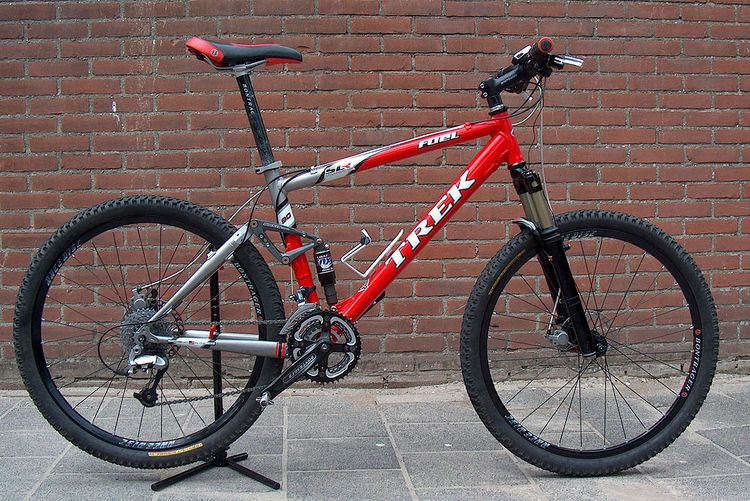 | ||
The following outline is provided as an overview of and topical guide to bicycles:
Contents
- What type of thing is a bicycle
- Types of bicycles
- History of bicycles
- Key developments
- Early developers
- Other developers
- Mountain bike developers
- Other notable cyclists
- Racing authors
- Other authors
- Organizations
- Technical aspects
- Uses
- Dynamics
- Performance
- Geometry
- Construction and parts
- Frame
- Drivetrain and gearing
- Steering and seating
- Brakes
- Suspension
- Wheels and tires
- Tracks
- Bicycle accessories
- Bicycle tools
- Standards
- Social and historical aspects
- In daily life
- In poverty reduction
- Legal requirements
- References
Bicycle – pedal-driven, human-powered, single-track vehicle, having two wheels attached to a frame, one behind the other. A person who rides a bicycle is called a cyclist or a bicyclist, and the activity is called cycling. Also known as a bike, push bike or cycle.
What type of thing is a bicycle?
Bicycles can be described as all of the following:
Types of bicycles
History of bicycles
Key developments
Early developers
Other developers
Mountain bike developers
Other notable cyclists
Racing authors
Other authors
Organizations
Technical aspects
The bicycle has undergone continual adaptation and improvement since its inception. These innovations have continued with the advent of modern materials and computer-aided design, allowing for a proliferation of specialized bicycle types.
Uses
Bicycles have been and are employed for many uses:
Types of bicycles
List of bicycle types Bicycles can be categorized in different ways: e.g. by function, by number of riders, by general construction, by gearing or by means of propulsion. The more common types include utility bicycles, mountain bicycles, racing bicycles, touring bicycles, hybrid bicycles, cruiser bicycles, and BMX Bikes. Less common are tandems, lowriders, tall bikes, fixed gear, folding models and recumbents (one of which was used to set the IHPVA Hour record).
Unicycles, tricycles and quadracycles are not strictly bicycles, as they have respectively one, three and four wheels, but are often referred to informally as "bikes".
Dynamics
Bicycle and motorcycle dynamics
Performance
Geometry
Bicycle and motorcycle geometry
Construction and parts
In its early years, bicycle construction drew on pre-existing technologies. More recently, bicycle technology has in turn contributed ideas in both old and new areas.
For details on specific bicycle parts, see list of bicycle parts and category:bicycle parts.
Frame
Bicycle frame The great majority of today's bicycles have a frame with upright seating which looks much like the first chain-driven bike.
By design:
By frame material:
Brands and makers of unusual frames:
Drivetrain and gearing
Power collection
Power transmission
Power modification
Power application
Steering and seating
Brakes
Suspension
Wheels and tires
Tracks
Some bicycles are built for specific tracks:
Or special tracks are built specifically for bicycles:
Bicycle accessories
Bicycle accessories
Bicycle tools
Standards
A number of formal and industry standards exist for bicycle components to help make spare parts exchangeable and to maintain a minimum product safety.
The International Organization for Standardization, ISO, has a special technical committee for cycles, TC149, that has the following scope: "Standardization in the field of cycles, their components and accessories with particular reference to terminology, testing methods and requirements for performance and safety, and interchangeability."
CEN, European Committee for Standardisation, also has a specific Technical Committee, TC333, that defines European standards for cycles. Their mandate states that EN cycle standards shall harmonize with ISO standards. Some CEN cycle standards were developed before ISO published their standards, leading to strong European influences in this area. European cycle standards tend to describe minimum safety requirements, while ISO standards have historically harmonized parts geometry. The TC149 ISO bicycle committee, including the TC149/SC1 ("Cycles and major sub-assemblies") subcommittee, has published the following standards:
Other ISO Technical Committees have published various cycle relevant standards, for example:
Published cycle standards from CEN TC333 include:
Yet to be approved cycle standards from CEN TC333:
Social and historical aspects
The bicycle has had a considerable effect on human society, in both the cultural and industrial realms.
In daily life
In poverty reduction
Legal requirements
The Vienna Convention on Road Traffic of the United Nations considers a bicycle to be a vehicle, and a person controlling a bicycle (whether actually riding or not) is considered an operator.
